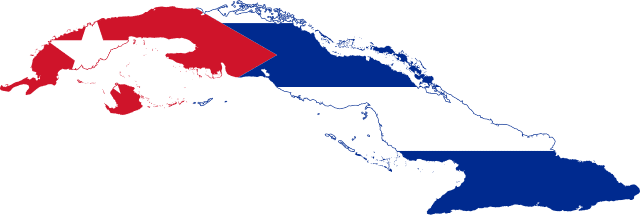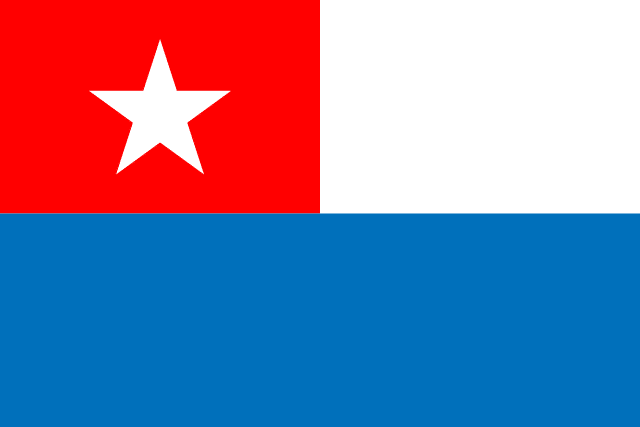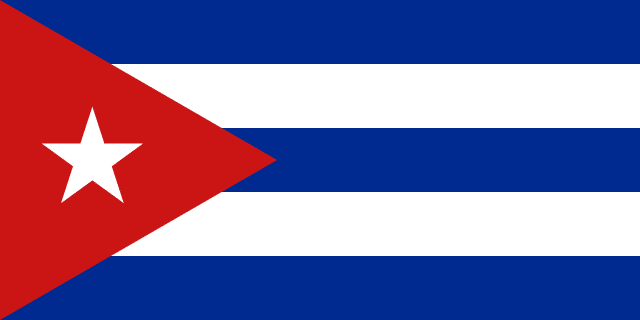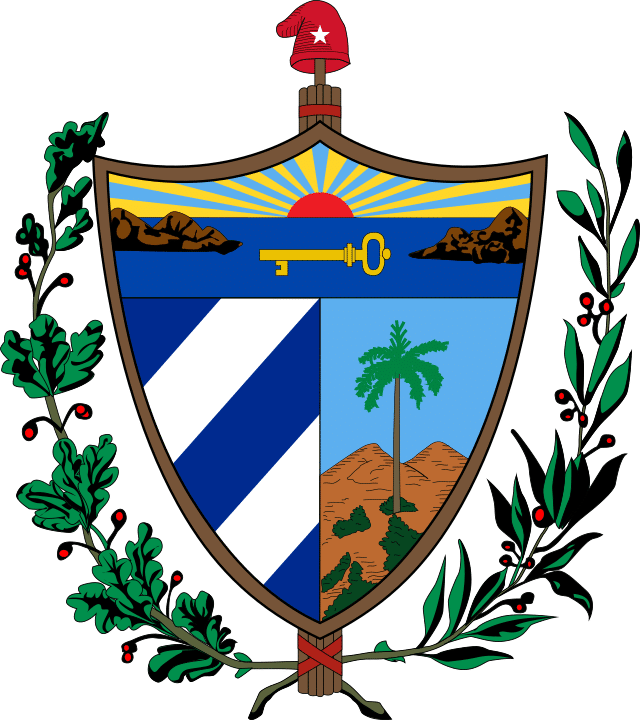Cuba’s flag tells a compelling story of tenacity, loyalty, and a sense of identity with its vivid colors and distinctive design. With its strong blue stripes, sparkling white star, and victorious red triangle, this famous insignia symbolizes a country steeped in a long history of upheaval and tenacity.
Let’s dive into the meaning of each component of this flag and discover the hidden symbolism behind it.
Overview of Cuba Country
Most of the characteristics of the modern Cuba flag are significantly determined by the features of the country and its history. Cuba, an alluring island nation with a rich history, varied landscapes, hardy people, and a dynamic culture, is located in the heart of the Caribbean. Cuba is strategically located in the Caribbean Sea, close to both Mexico and the United States to the east. Due to its geographic setting, it has a tropical climate, stunning beaches, and a distinctive fusion of cultural influences.
Cuba always operates on UTC-5, Eastern Standard Time (EST). Thanks to this reliable time in Cuba, visitors easily organize their schedules and activities.
Cuba is the biggest island in the Caribbean archipelago, measuring over 1,250 kilometers (775 miles) from east to west. Its landmass is made up of a variety of geological characteristics, such as rich valleys, sweeping plains, rough mountain ranges, and breathtaking beaches.
Cuba, which has a population of over 11 million, is renowned for its kind and hardy people. The Cuban people, sometimes known as “Los Cubanos,” are proud of their history and culture and have a strong sense of national identity. With Spanish history serving as the cornerstone of Cuban civilization, the populace is a colorful fusion of ethnicities. Influences from African, Native American, and other immigrants have helped to create the multicultural mosaic that characterizes Cuban identity.
Cuba’s different ecosystems are reflected in the beauty of its natural surroundings. The nation has a broad variety of natural beauties, from lush rainforests and mangrove swamps to brilliant coral reefs and lovely beaches. A total of 5,746 kilometers (3,570 miles) of Cuba’s coastline are made up of immaculate beaches, including Varadero, Guardalavaca, and Cayo Coco, which draw tourists from all over the world.

Design & Symbolism of the Cuba Flag
The Cuba flag has an equilateral red triangle on the hoist side and is made up of three vivid horizontal stripes: two blue stripes at the top and bottom, and a broad white stripe in the middle. A white five-pointed star in the center of the red triangle is facing the hoist side. The width and length of the flag are normally divided by two in a ratio of 1:2.
Each component of the Cuba flag has a deep symbolic meaning. The three departments that once made up Cuba during its struggle for independence are symbolized by the blue stripes. The nationalism and unshakeable spirit of the Cuban people are embodied by these blue stripes.
The white stripe is the largest and most noticeable part of the flag. It represents honesty, purity, and a desire for peace. Regardless of background or ideas, it stands for the goal of unification among all Cubans. Additionally, the color white represents the purity of the revolutionary cause and the pursuit of freedom.
The “Estrella Solitaria,” or “Lone Star,” a red triangle, symbolizes the suffering and sacrifice endured by those who battled for Cuba’s freedom.
A white five-pointed star, which stands for independence and freedom, is contained within the red triangle. This star, which faces the hoist side, represents the historical ties between Cuba and its neighbors in Latin America who battled for independence. The star acts as a lighthouse, pointing Cuba in the direction of a more promising future.
The design of the Cuba flag has a deep connection to the nation’s revolutionary past. On May 20, 1902, it was formally adopted after Cuba was freed from Spanish colonial dominance. The flag’s timeless significance may be seen in the fact that its design, which was motivated by the principles of the Cuban Revolutionary Party, has not altered since it was first created.
History Of Cuba Flag
The Cuba flag is closely linked to the nation’s struggle for independence and quest for freedom. Let’s take a look at the stages of development of the flag.
First Cuba Flag
Narciso López, a pioneer in the fight for Cuban independence, originally unfurled the flag, also known as “La Estrella Solitaria” or “The Lone Star,” in 1849, as we already mentioned above.
As a zealous supporter of Cuban independence, López intended to develop a symbol that would inspire Cubans to struggle against Spanish colonial power. López created the flag with three blue stripes to represent the departments of Las Villas, La Habana, and Oriente, which were important areas in the war for independence. López was inspired by the principles of the United States and its flag. A crimson backdrop and a white star were also seen on the flag.
López oversaw the “López Expedition” in 1850, an effort to free Cuba from Spanish rule. On the coast of Cardenas, the Cuba flag was raised for the first time during this mission. The mission, however, ran into trouble, and López was taken prisoner and put to death by Spanish authorities.
Revolutionary Flag
The flag was transformed into a compelling representation of resistance and optimism for the Cuban independence cause after López’s passing. Later, revolutionary leaders carried it, and it gained widespread recognition as a potent symbol of Cuban nationality.
A variant of the flag was flown during the Ten Years’ War (1868–1878), a significant armed battle against Spanish sovereignty. With the red triangle and white star in the canton, it had a white cross that represented each of Cuba’s four regions.

Flag of Independent Cuba
As the Cuban War of Independence broke out in 1895, the flag underwent more changes. It was decided to use the present pattern, which consists of white and red triangles, a red triangle, and a white star. The white star was shifted to the hoist side within the red triangle, while the red triangle’s red triangle was kept from earlier incarnations.
Cuba became independent of Spain after the Spanish-American War ended in 1898. However, the country was under American control until 1902.
Current Cuba Flag
On May 20, 1902, the current flag was formally recognized as Cuba’s national flag during this time. Since that time, the Cuba flag has not altered and continues to stand for the people of Cuba’s tenacity, patriotism, and resolve. It is a representation of the country’s valiant fight for independence and dedication to defending its ideals.

Coat of Arms of Cuba
Cuba’s coat of arms’ current appearance was formally approved in 1906. It has a landscape with a machete expressing the country’s desire to defend its freedom, a key signifying Cuba’s strategic location in the Caribbean, and a Phrygian hat signifying the spirit of liberty.
The three previous divisions of Cuba throughout its struggle for independence are represented by the shield’s central blue and white striped design. A key embedded within the shield represents Cuba’s advantageous location in the Caribbean Sea. The machete on one side of the key stands for the Cuban people’s fortitude, tenacity, and preparedness to defend their freedom. The Phrygian hat, a symbol of liberty and freedom, is on the other side. The crest reflects the independence, tenacity, and patriotism that are ingrained in Cuban history and culture.

Cuba Flag Protocol
The Cuban national flag protocol is a collection of rules that specify how the flag should be used, displayed, and handled in an appropriate and respectful manner.
- Cuba flag hoisting and lowering are observed at sunrise and dusk, respectively. It should be carried out carefully and gently.
- The flag may be flown at half-staff as a symbol of grief or for a period of general mourning. Usually, this is done in commemoration of late prominent citizens or in times of national catastrophe.
- The Cuba flag should be placed in a position of dignity and prominence when exhibited with other flags. In relation to other flags, it ought to be placed higher or to the right.
- The size of the flag should match the height of the flagpole. Never let it be smaller than other flags flown from the same pole. The hoist side of the Cuba flag should be shown when it is flown from a flagpole.
- The Cuba flag should be handled with respect. It shouldn’t be permitted to contact the ground, become dirty, or sustain any harm. When raised, lowered, or transported, it should be handled gently and cautiously.
- Cuba holds a rite known as “El Toque de Diana” every morning at six o’clock. Throughout the nation, during this event, the flag is raised as the national anthem is played in public spaces and governmental structures.
Conclusion
Cuba flag depicts the undying resiliency, steadfast patriotism, and unyielding tenacity of the Cuban people with its colors, stripes, star, and triangle. It serves as a reminder of their tenacious search for independence and their steadfast love for their country.
The Cuba Flag continues to uplift unity and hope, whether it is flapping in the breeze or being proudly exhibited. That’s how it instills a sense of pride and belonging in the hearts of everyone who calls Cuba home.